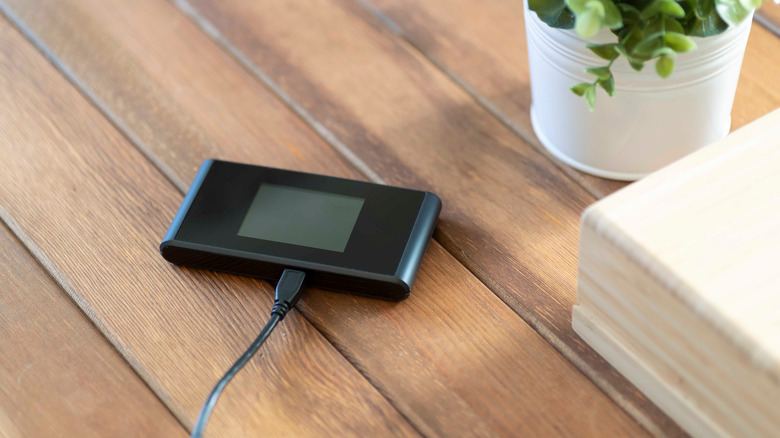The Easiest Way To Get Wi-Fi In Your Car
We may receive a commission on purchases made from links.
Wi-Fi is everywhere, convenient, and handy when using things other than your phone, like a tablet or Nintendo Switch. One place where you probably won't find Wi-Fi is in your vehicle, and this can be a pain if you have passengers in your car (especially kids) who want to browse the internet or download a game.
Manufacturers occasionally put cellular modems in non-phone devices, but this is uncommon. Each device typically requires a separate data plan from your wireless carrier or a monthly fee from the manufacturer. Even Amazon, which used to include free 3G wireless on their Kindle devices, has stopped in recent years. When 3G networks were discontinued in the U.S. at the end of 2021, older Kindles were cut off. Amazon doesn't even offer cellular connectivity on their current Kindles — except for the 2019 Kindle Oasis, which also still has MicroUSB, if that tells you anything.
So what are you supposed to do if you're out and about, but want to stream a video or hop on your laptop? You can look for a nearby cafe, bookstore, or fast food place. Still, the most convenient option would be a Wi-Fi connection in your car, so you're never too far away. Turning your vehicle into a hotspot on wheels is possible, but your options vary in cost and connectivity.
Share your phone's connection
The simplest way to have Wi-Fi access in your car is by using your phone as a mobile hotspot. Most smartphones can do this, so you already have the hardware you need. You can set up just about any Android or iOS device as a Wi-Fi access point that uses the phone's cellular plan for data. It's usually just a simple matter of turning it on, and then connecting to the Wi-Fi network with your device.
The problem with utilizing a hotspot lies in carrier restrictions. Even if your plan has unlimited data, very few have unlimited hotspot usage (and the ones that do are typically costly). Limits can range from 5 GB to 50 GB. Some "unlimited" plans make you pay extra to use the feature, and a few disallow it entirely. If you have a limited data plan, you might get to use your regular data pool, just a portion of it, or your carrier may not allow hotspots at all. Hotspot data may also be limited to 4G or even 3G connections. Check with your carrier to find out the details before making any decisions.
There's also the fact that phones aren't built to provide Wi-Fi access to other devices. Their signal may be poor or have a limited range, and though it works in a pinch, it's typically not ideal.
Buy a mobile hotspot device
Many carriers offer hotspot devices dedicated solely to providing Wi-Fi access. These have separate plans instead of piggybacking off your phone's plan, so you're not stuck with your regular carrier and can shop around. Data limits can vary from 5GB to 150GB and up. You'll need to purchase some hardware, with prices ranging from under $100 to $500. Hotspot devices usually have better signal quality than phone hotspots.
Hotspot devices are usually small boxes around the size of a deck of cards. Some have touchscreens and lots of options, while some are simpler. The nice thing about these devices is that they often come with rechargeable batteries, so you can use them outside of the car as well. There are also hotspot devices from companies like Harman and Hum that plug directly into the car's OBD-II port, and can offer safety and diagnostic info, as well as track your car's location.
Finally, a few car manufacturers offer built-in hotspots that provide the best Wi-Fi and cellular signal. These have dedicated plans from a specific provider, such as AT&T or OnStar. Only a few brands are offering this right now, and only for very recent model years. Check your owner's manual and the manufacturer's website for more info about their plan costs and features. If you're feeling brave, you can install a cellular modem similar to these in any car, but this is very expensive and requires some DIY know-how, so it's not the most convenient solution.


